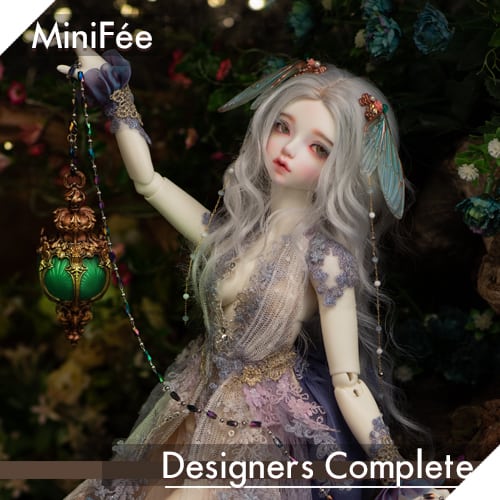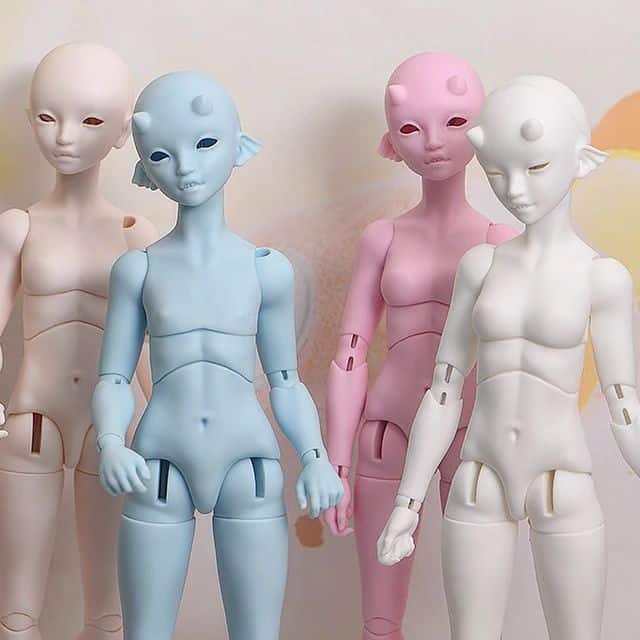A World of Dolls: The History of BJDs
The Appeal of Ball Jointed Dolls

(Image courtesy of Legenddoll)
It’s hard to deny the charm that ball-jointed dolls (BJDs) hold for many collectors. These dolls have gained a devoted following worldwide, featuring intricate articulation and lifelike proportions. With their expressive faces, joint limbs, and customizable looks, BJDs can be tailored to reflect any number of styles and personalities.
As an avid collector, I’ve often wondered about the origins and significance of these fascinating dolls. Understanding where BJDs came from and how they’ve evolved can help us appreciate their appeal even more deeply.
Why History Matters
Digging into the history of BJDs takes us on a journey through cultural traditions, artistic movements, technological advancements, and social trends. It helps us understand why these dolls are more than just toys or shelf decorations—they’re tangible expressions of human creativity.
So let’s dive into the world of ball-jointed dolls—where they come from, how they’ve grown in popularity over time, what makes them so compelling to collect and customize—and explore some of the debates surrounding them today.
Early Origins
The Emergence of Ball-Jointed Dolls in Europe During the 19th Century
The history of ball-jointed dolls, or BJDs for short, can be traced back to Europe during the 19th century. These early dolls were made from materials such as bisque and porcelain and were often modelled after popular literary characters of the time.
They typically had fixed limbs and lacked the mobility that modern BJDs possess. However, they laid the foundation for what was to come.
The Influence of Asian Cultures on Modern BJDs
While European doll-making played a role in the early development of BJDs, it was ultimately Asian cultures that influenced their modern form. Japan, China, and Korea are particularly significant in this regard, as they have embraced the art form and turned it into a thriving industry.
The look and style of modern BJDs can be linked to popular characters, anime, and manga aesthetics that have been popularized throughout Asia. As a result, many BJD enthusiasts associate these dolls with Asian culture and view them as a form of artistry.
The Evolution of BJD Dolls: Modern Development
The Rise of BJDs in Japan and Korea During the Late 20th Century
The popularity of ball-jointed dolls skyrocketed in Japan and South Korea during the late 20th century. This led to a surge in demand for dolls that were not only beautifully crafted but also highly customizable. Doll companies began to cater to this emerging market, producing dolls that appealed to collectors looking for unique pieces that could be tailored to their tastes.

In Japan, Volks Inc. is one of the most well-known doll companies responsible for popularizing BJDs known as Super Dollfies or SDs. Meanwhile, companies like Fairyland and Luts have become fan favorites among collectors in Korea.
The Evolution of Materials Used to Create BJDs: From Porcelain to Resin
The materials used to create ball-jointed dolls have changed drastically over time. Traditional porcelain was once a favored material for creating dolls due to its delicate beauty; however, it was also fragile and prone to damage.
With the rise of modern technology and advancements in materials science, the resin has become a go-to material for crafting modern BJDs. Resin is lightweight, durable, and easily molded into different shapes and textures.
It’s also easier for artists to customize with paint or other mediums. Companies like Iplehouse (Korea), Soom (Korea), and Volks(Japan) have made great strides in perfecting the art of creating resin BJDs with intricate details that rival those made from traditional materials.
Overall, modern development has allowed artists greater freedom in crafting ball-jointed dolls. New materials like resin have revolutionized how these dolls are made while retaining their timeless charm and appeal.
Popularity and Growth
The spread of BJD culture through online communities and social media
The rise of the internet has undoubtedly played a significant role in the popularity of BJD dolls. Online forums, blogs, and social media platforms have provided a space for enthusiasts worldwide to connect with each other and share their passion for these unique dolls. Through these online communities, collectors can share doll care and maintenance tips, showcase their collections, and even organize meetups or events.
The rise of customization and personalization in BJD collecting

(Image courtesy of Legenddoll)
One of the most appealing aspects of BJD collecting is the ability to customize and personalize each doll. Unlike traditional dolls that come pre-made with fixed features, BJDs offer collectors the chance to create unique characters by customizing everything from their wigs to their clothing.
Some collectors take this a step further by creating custom faceups (painting on the doll’s face) or even sculpting entirely new body parts. This level of creative freedom has allowed for an incredible variety within the BJD community, making each collection truly one-of-a-kind.
Overall, online communities have helped foster a strong sense of community amongst collectors, while customization options have allowed people to create dolls that are truly unique to them. These factors have made BJD collecting an incredibly popular hobby for people worldwide, with no signs of slowing down any time soon.
Controversies and Criticisms
Appropriation and Cultural Insensitivity
One of the major controversies surrounding BJD dolls is the issue of appropriation and cultural insensitivity. Some dolls are designed to look like characters from anime or manga, which has led to concerns about Japanese culture being commodified for profit.
Additionally, some dolls are marketed as “exotic” or “ethnic,” which can be seen as objectifying and fetishizing certain cultures. Critics argue that these practices perpetuate harmful stereotypes and fail to respect the diverse backgrounds of those represented by such dolls.
High Cost and Exclusivity
Another criticism levelled against BJDs is their high cost and exclusivity. Some brands can cost thousands of dollars, making them out of reach for collectors. This exclusivity has led to accusations of elitism within the community, with some arguing that it shuts out less wealthy collectors who may still have a deep love for BJDs.
Furthermore, some critics argue that this high cost is the reason why people turn to purchasing recast(counterfeit) dolls. Overall, while BJDs have become increasingly popular in recent years due in part to social media exposure, there remain important issues surrounding their creation, marketing, and distribution that must be addressed by the industry to ensure a bright future for these unique and beloved art pieces.
Future Outlook
Potential for continued growth and innovation within the BJD community
The world of BJDs is constantly evolving, with new artists and manufacturers entering the market every year. With the increased availability of 3D printers, we can expect to see even more innovative designs, materials, and customization options available to collectors made by small time artists. With the internet making it easier for people worldwide to connect and share their love for BJDs, there is no doubt that this community will continue to grow in size and diversity.
Possibility for greater diversity in representation within the industry
One area where the BJD industry has faced criticism is in its lack of diversity in representation. Currently, many dolls are designed with a very specific aesthetic that can be limiting for collectors who do not fit into that mold.

However, we are seeing more artists who are also avid hobbyists from diverse backgrounds enter the market and creating their own diverse dolls. As consumers demand more inclusive options, we are already starting to see a shift towards greater representation of different races, body types, abilities, and gender expressions within the world of BJDs.
Conclusion
A BJD History Worth Knowing

(Image courtesy of Legenddoll)
Ball-jointed dolls are a fascinating and beloved hobby many worldwide enjoy. As we’ve explored, their history is rich and complex, with origins dating back to the 19th century in Europe.
Today’s modern BJDs owe a great debt to the influences of Asian cultures on their design and aesthetics and to advancements in materials like resin. The popularity of BJDs has grown significantly over the past few decades, largely thanks to online communities and social media.
Controversies That Matter
While BJDs are often seen as purely whimsical and fun, they have not been without controversy or criticism. Some have raised concerns about appropriation or cultural insensitivity in certain aspects of their creation or marketing.
Additionally, high costs associated with certain brands have made them an exclusive luxury items for some collectors. It’s important for those who enjoy BJDs to remain mindful of these issues.
The Future of Ball-Jointed Dolls
Despite some challenges, ball-jointed dolls continue to be a vibrant and exciting hobby with a promising future. Advancements in technology offer new opportunities for customization and personalization that may become more accessible over time. Additionally, there is potential for greater diversity within the industry that could attract even more fans from all walks of life.
Whether you’re an established collector or just discovering this unique subculture for the first time, there’s always more to learn about BJDs. The history behind these dolls is fascinating and worth exploring, while their future remains bright with untapped possibilities. If you want to learn more about the latest BJD news, check out my Youtube channel.
Recent Posts
Come join my BJD Newsletter where you will learn about new dolls coming out, BJD doll sales, and artist highlights! There will also be other BJD goodies just for you!
When to Restring: Recognizing Signs Your BJD Needs a Tune-Up
Learn how to recognize signs your BJD needs a tune-up and restringing process. Maintain your doll's stringing for longer life with this step-by-step guide.
